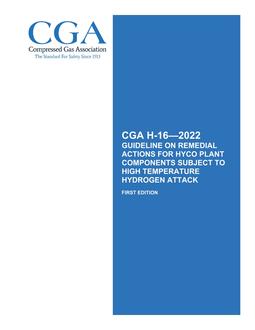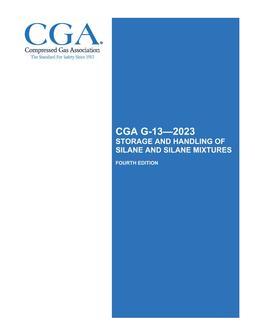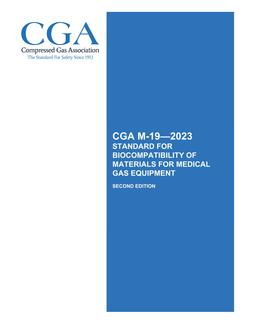
CGA H-16
- Comments Off on CGA H-16
- CGA
Click here to purchase
Industrial gas companies operate and maintain hydrogen production facilities worldwide ranging in scale from small (< 1MM SCF per day) to the world’s largest facilities (> 150MM SCF per day). These plants, and the related HYCO facilities that produce carbon monoxide and syngas products, generally involve the handling of flammable gases at high temperatures typically up to 1700 °F (925 °C) and moderate to high pressures. These processing conditions can present inherent hazards that should be recognized and properly managed to ensure the mechanical integrity and safe operation of the facilities. One such hazard is a phenomenon known as high temperature hydrogen attack (HTHA).
This publication will provide guidance, heuristics, and some examples of methodologies for the review of existing HYCO plant assets to determine their potential for HTHA-initiated cumulative damage. It will also provide guidelines for risk categorization, inspection strategies, and recommendations on risk mitigation.
This publication will identify actions for the owners and operators of HYCO plants (including carbon monoxide and syngas plants) in response to the updated guidance on the HTHA mechanism documented in API RP 941. The guidance in CGA H-16 can apply to all scales of hydrogen production and consumption facilities that utilize the relevant materials of construction.
Risk of the HTHA mechanism will be determined for the components that are exposed to hydrogen-containing gas at a temperature above 400 °F (205 °C) (with some margin below 400 °F [205 °C] to allow for uncertainties). Examples of services in a HYCO plant that would typically require assessment are provided in Section 8.
It should be noted that there are other industries that operate hydrogen or syngas producing plants for purposes other than hydrogen production. For example, the ammonia and methanol industry operate syngas production facilities and should find relevant guidance from this publication.
This publication is not intended to address the details of design or construction of new facilities relative to HTHA. Please note that in this publication, the term “low alloy steels” refers to chromium-molybdenum (CrMo) steels.
Product Details
- Edition:
- 1
- Published:
- 2022
- Number of Pages:
- 18
- File Size:
- 1 file , 390 KB
- Note:
- This product is unavailable in Russia, Ukraine, Belarus



